#sleuth2k7
Explore tagged Tumblr posts
Text
Visualizing the Building Theory using BBC Sherlock
@amateur-deductions recently did a post on the Building Theory. In his words:
[The Building Theory] serves as a wonderful way to illustrate how much a deduction is a progressive process, with multiple little steps between observations and conclusions. It's also an amazing tool to analyze other people's deductions and break them down in a way that allows you to map out their trains of thought and learn from them
He provides an excellent explanation of how the theory works: basically, you think of the process of deducing as constructing a building, with observations and subsequent deductions representing bricks that are stacked on top of one another, building up to more complex deductions based on those original observations & deductions.
I’ve always liked this theory because it makes the process of deduction more tangible and visual, which helps me learn, and I know others like to use visuals to learn too.
I’ve mapped out deductions from BBC Sherlock before, so I thought sharing that here would help provide a visual supplement to @amateur-deductions‘ work.
When Sherlock and John first meet, Sherlock asks: “Afghanistan or Iraq?”
You can watch the scene where he asks that here. And the scene where he explains how he got to that here.
While the show provides a decent verbal breakdown of how Sherlock got to that question, we can also visualize his process like this:
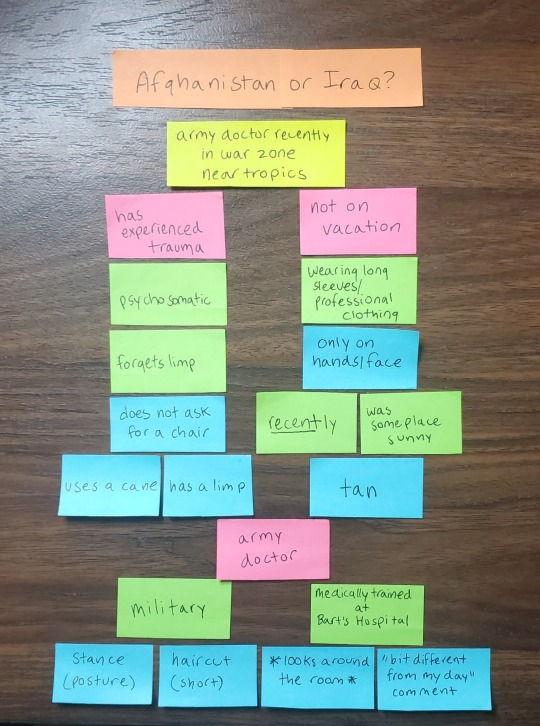
blue: observations // green: deductions made from observations // pink: deductions made from prior deductions & observations (level 1) // yellow: deductions made from prior deductions (level 2)
As you can see, Sherlock uses his initial observations about John to make deductions, and then uses those deductions to make additional deductions. All of this culminates in him asking John “Afghanistan or Iraq?”
Let’s break down this process a bit. We can think of this building as being made up of a bottom floor, and then two supporting sides that work together to build onto that bottom floor and also support the roof placed on top.
First, the bottom floor:
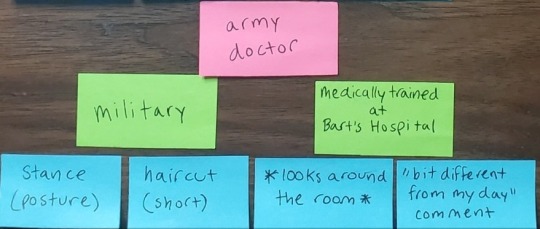
When John enters the room, Sherlock looks up at him and makes four observations about him, which he uses to make two deductions.
1. stance + haircut = military
** Sherlock knows that these observations = military from knowledge he has about the appearance/behavior of people in the military.
2. looks around the room + says “bit different from my day” = medically trained at Bart’s Hospital
** Here Sherlock uses a combination of knowledge and logic. He knows that Bart’s Hospital is a well-known training hospital and if John is familiar with the lab that the pair are standing in (as opposed to a patient room), he must have been a student there.
Sherlock then takes those two deductions and combines them to create another: military + medically trained = army doctor. That deduction forms the base of the rest of the building.
Next, there are two supporting sides. Let’s call them the “limp” side and “tan” side, as those are the two observations that form the base of each.
First, the limp:
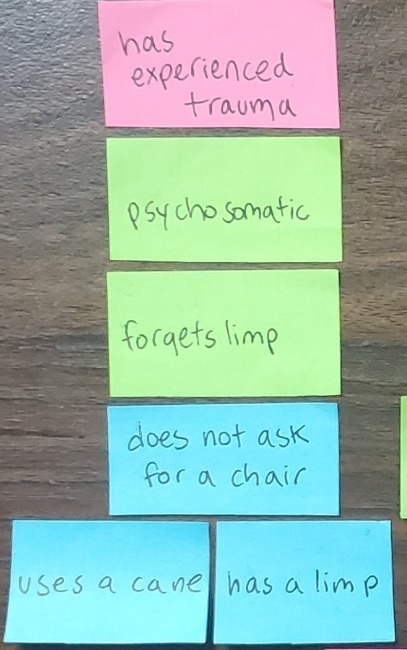
Sherlock begins with several observations:
1. has a limp and uses a cane.
2. does not ask for a chair to sit in.
** Knowledge: Sherlock knows that people with limps may look for or ask for somewhere to sit.
From this, Sherlock deduces that John:
1. forgets he has the limp.
2. Why? Because the limp is psychosomatic.
** Knowledge: Sherlock knows about psychosomatic injuries.
3. Which means that trauma caused the limp.
Second, the tan:

Again, Sherlock begins with two observations, and each have their own subsequent deduction.
1. has a tan. = was recently in a sunny place.
** Knowledge: Sherlock knows that people get a tan from being in the sun, and that tans fade over time.
2. only has a tan on his hands and face. = was in a sunny place while wearing long sleeves, so he was not on vacation or sunbathing, but was on business.
** Knowledge: Sherlock knows that when people go on vacation to a sunny location, it is not typical to wear long sleeves or professional clothing but rather dress casual (shorts and a t-shirt, swimsuits, etc.).
Here is where Sherlock’s process culminates into the question. Relying on the deduction that John is an army doctor, and combining that deduction with these two new deductions (1) has a limp from trauma, and (2) was recently in a sunny place for business/work, Sherlock makes this final deduction: John is an army doctor who was recently in a war zone near the tropics.
He cannot go further than this though, as there are a few locations that fit that description. So, Sherlock engages in order to get the information he needs: “Afghanistan or Iraq?”
~
I hope this provided a helpful visual example of the Building Theory - if anybody has any questions or wants me to go into more detail on any aspect of this example, please ask!
71 notes
·
View notes
Note
ways I've used deduction in a more day-to-day setting
- to know when something is bothering/wrong with friends
- to know when someone is nervous/upset in social situations - really having a better awareness of how people are acting in social situations (and why) is sooo helpful
- to quickly learn about a new person you meet, instead of having to wait for them to share things/or ask them - basically good for vibe checking new people
- to help calm people down when they're catastrophizing about something
- when living with others, to figure out things like "who made this mess" or "who moved X item I keep in Y place in the fridge"
- to figure out why someone responded a specific way to something I said/did (if you have anxiety and on autopilot assume the worst, deduction can help counteract that)
Hi!!! How can deductions be used in day to day life, or like, usefully? And how have you made useful deductions? Sorry if that made little sense
Hi! I see you sent this question in the past two days, i'll gladly answer it, but in case you send any other questions in the future and i don't answer them as quickly i'll inform you that usually all the questions of the week are collected in my inbox and you'd get your answer on a Monday (this week i had some scheduling problems so i pushed it to Wednesday), so if you don't get as quick an answer next time just wait for Monday!
Now, regarding your question! There's many ways deduction can be used in daily life, sometimes it even depends on what you do for a living. For example i know psychologists and other healthcare profesionals have to rely on non verbal communication and information they gather from observation, along with what they're told, since patients can't be relied upon to be transparent and honest all the time, or even know what information is releant to share. In this case deduction can be massively useful.
On a more general note, it depends a lot on the type of relationships you have, i know people who use deduction to interact with their friends, it allows them to know when they're feeling upset or worried, and about what, and act accordingly, all without needing to do more than just glance at them. I know people who use deduction to navigate social situations because they're not good at interacting with people and having the extra information deduction provides helps. Personally i'm someone that introduces deduction into everything i do, from acquiring helpful knowledge when talking to superiors, to knowing what waiter is best to call over at my table cause they've gotten more hours of sleep.
I recommend you watch Sherlock, House M.D., The Mentalist, and all of these deduction heavy shows that sometimes showcase how these characters use their skills casually, it's really not much different than what you see there. If you want a blog that really goes into casual uses of dedduction i'd check out @froogboi 's blog, it's full of everyday life uses of deduction
24 notes
·
View notes
Text
Deducing With Disorders Pt. 1
Dissociative Disorders: TW - Mentions/Descriptions of Dissociation
Credit to @sleuth2k7 for the idea
So quick disclaimer: I am not a certified psychologist, I am giving generalized advice for deducing with disorders that I have been diagnosed with based on my personal experience. Nothing is one-size-fits-all.
When I was 15 I was diagnosed with derealization/depersonalization disorder. DR/DP is one of three types of dissociative disorders spanning approximately 1%-2% of the population, and as with all dissociative disorders, involves repeated episodes of disconnection from one's sense of self and surroundings. With DR/DP specifically, I experience long episodes of what I can only describe as having a VR headset glued on where you can only watch what's happening to your character, and you just have this certainty nothing in this world is real, occasionally being removed from the driver's seat entirely and placed further back in the VR world by some part of your brain that belongs to you on every count except your own.
TLDR: Am I real? Are you? How to deduce when you aren't sure if you're real is the question.
Answer: I personally do reality checks to start, and I incorporate deduction into that. Am I real? Well does 2+2 still equal 4? Do those baggy pants plus that ill-fitting suit still mean that this teenager is wearing his dad's clothes? Probably. Let's find out.
So when we're reconnecting to ourselves and our surroundings, we look for things that verify our experience as truly our own. Make it a game. Certain deductions are worth certain points, it can help to have a friend to play with. A profession is worth 5, a relationship status is worth 10, etc. No friend? No problem. The classic grounding method of listing 5 things you see, 4 you hear, 3 you can touch, 2 you can smell, and 1 thing you can taste can be built upon to be a more mindful exercise that you don't just run right through.
When listing your sensory observations, use your list to then deduce things about the person. For example, I used to smoke, quit like 2 or 3 years ago, but my ex would always be able to know I had been smoking when I was within 20 feet of her. She could see the nicotine stains, the smudge of ash on my thumb from flicking the cigarette, the lump of a crumpled cigarette pack in my pocket, and not just the obvious pieces of information, she saw the cologne in my bag, and the look on the faces of my friends who would smoke with me before school. For sound she may have heard the dry smoker's cough, the crackling of a lit cigarette, the spritz of a bottle of cologne before I walked up to her, and the click of a lighter in my fidgeting hands. She would reach out and touch the grainy bits of ash on my shirt, and feel the tremors in my hand, and the movement of the pack in my pocket. Obviously, she could smell the tar and smoke of the cigarette, even under the smell of my cologne. Even if I had brought a change of clothes, sprayed copious amounts of cologne, and washed my hands, she could always taste it when we kissed.
All this is of course the long-winded way to say that mindfulness is a invaluable tool when deducing with a disorder that separates you from reality. Hopefully, you can use these mindfulness techniques in conjunction with abductive reasoning to reconnect with yourself and your surroundings. I apologize for the brevity of the post, but rest assured the quality and frequency of posts should be back up to standard soon.
#logical reasoning#deduction#logical deduction#deductive reasoning#psychology#derealization#depersonalisation tw
13 notes
·
View notes
Text
Why are there not so many posts recently here?
This blog is a go-to also in the future times I wouldn’t be posting.
This post is getting its first views, for which I’m incredibly grateful, and I feel like because of this I should explain the lack of posts in the last few days. There are a few reasons behind it so let me explain them here. So firstly I’m going to clarify that I didn’t lose interest in deduction or take a break(I’m making it look like I haven’t posted for years 😅). Therefore now having clarified that I’m not quitting let me give the first reason: lack of interesting things to post about. I haven’t made any interesting enough deductions to post them here. This is a place I post my more interesting deductions(if I posted every deduction this blog would be full of deductions of handedness and basic observations) and this brings us to the next reason which is also the reason for the lack of more interesting deductions. I’m somehow busy. The last few days were exciting and cool etc. but kinda busy so I couldn't make many interesting deductions. And the next reason and the last one is that I’m a beginner and I’m trying to make some interesting deductions but I’m not always able to. I think that the best way for me to not be stuck in this place is just to keep learning and practising, so yeah I guess that’s it.
Thanks for reading
And special thanks to @kaizo1573 and @sleuth2k7
-BH
2 notes
·
View notes
Text
using all 5 senses in observing and deducing is a pretty well known tip I think
for one, sometimes there are sounds with a source we can't see, so we only know about them through sound
we also can't *see* how things taste or feel (though we can get a vague idea through sight)
a less obvious part of this is that multiple senses can be used at the same time - deducing is sometimes visualized as a step-by-step process where each step happens in succession, and that's mainly to help beginners learn - eventually, the thought process goes faster and can overlap *because* we overlap our senses in everyday life
for example, the other day i was walking through my neighborhood
i was focused on the sky, and to the right, not to the left - i was watching the sky for a few things, and then dragging my hand across the stone wall to the right, so that's already using multiple senses at once
im walking and i realize i smell honeysuckle, so i look around and realize to my left is a line of honeysuckle bushes
had I been looking All Around, I'd have seen the honeysuckle and not even needed to smell it (since I know what honeysuckle looks like), but my eyes were preoccupied elsewhere, and I'd have missed the bushes if I hadn't been able to smell them in place of seeing them
so, point here is yes sight is probably what you're focused on when deducing, but while you're looking around using your eyes, stay aware of any noises or tastes or textures that pop up in your periphery
#deduction#deductionist#learning deduction#sherlock holmes#deduce#deductive reasoning#observation#sherlock#logic reasoning#sleuth2k7
14 notes
·
View notes
Text
Christmas deductions - whose wrapping paper is whose?
This post is coming a few days later than I intended, but it is still December! Inspired by @studies-in-the-art-of-deduction's post about deducing presents and @a-study-in-sepia's post deducing presents under her tree.
Each year, my parents randomly choose a different wrapping paper for the seven people in our house. For the past few years, my parents have had my siblings and I guess whose wrapping paper belongs to who - whoever gets the most correct gets to open the first gift. Not important to the post, but I did win this year, buuuut I only got 3 out of 7 of my guesses correct. For this post, I'm focusing on the 3 correct guesses and how I used observations/deductions to get those 3 right. I say both observations and deductions because I'm including information collected in the weeks leading up to Christmas and also physical examination/deducing of wrapped gifts.
--
I get Amazon package notifications on my phone as my family shares one account, and I saw a 3D printer pop up in November. I knew that my Dad had wanted one for years and had been collecting the plastic-y materials for 3D printing for years too. So that's his present: I know from this that one of the larger presents must be a 3D printer. But which box is his? There were four larger presents - 3 different wrapping papers, with one wrapping paper being used twice. Related to that, I remembered a conversation with my Mom in November - she had been excited about a present for Sibling Y and told me about it, referring to it as one of the presents in the stack of four large boxes. She then slipped and mentioned that the item was in two separate boxes. I now know Sibling Y's wrapping paper. So I went to the other two large presents and picked both up: one was light and one was much heavier - 3D printers are heavy, so I know what my Dad's wrapping paper is. (Note: I double checked this deduction by looking at whether that wrapping paper had very few gifts, as my Dad typically has the fewest, and that wrapping paper did.) With the last large present, I did not deduce correctly whose it was - but I know why I didn't so I'll explain. Months ago, I was told how Sibling R's suitcase had been broken and how she would get a new one for Christmas. I forgot this conversation, because if I had remembered I would have known the final large box was a suitcase. Why did I not realize this when I picked the box up? Because of a conversation I remembered in November where my mom had told me she wasn't sure how I'd fly back to my place with my gifts. I swear she said that I had a gift or two that was too "big" but she told me post-Christmas that she had meant too heavy, not big. I had taken it as meaning my wrapping had to be the one the fourth large box was, since that was the only box left that would be too big for a suitcase - which is hilarious to me now because it literally was a suitcase. Oops. Lesson learned though: don't look at physical data through the lens of a conclusion you'd come to before looking at the physical data.
Those deductions were made through a combination of paying attention prior to Christmas and physical observations. The third wrapping paper that I deduced right was Sibling N's - I found two presents, deduced what was inside, and based on that knew which sibling that was. Box #1: I shook this box and could hear a liquid sloshing around inside. In the weeks before Christmas, there had been a lot of talk of body sprays and perfumes from Siblings R and N. Based on how the sloshing sounded, this was not a perfume bottle, since the sloshing was too "big" if that makes sense - I could tell the bottle was bigger and there was more liquid than a perfume bottle. Sibling R uses perfumes and doesn't like body sprays, and Sibling N predominantly uses a body spray - so I deduced that this box had her specific brand of body spray. I marked the wrapping so when she opened it on Christmas day, I could confirm that I was right (I was). Box #2: I picked up a few other boxes with the same wrapping as the body spray, looking for any indication of another gift Sibling N would be likely to get. One was a long (maybe a foot (or 2 hands length), rectangular box. I shook it and based on the sound I thought there was one item inside: similar shape to the box, long and rectangular. I deduced that this was a flat iron or curling iron of some kind, since several of my siblings, including Sibling N are always fighting over/stealing each other's flat irons. I confirmed this deduction on Christmas - she had gotten a flat iron.
I may make a second post that includes where I went wrong with the 4 incorrect guesses, but I will definitely do another post like this one next year - it was fun. :)
9 notes
·
View notes
Text
it constantly boggles me how fans of a show about logical reasoning and deduction often fail to apply those skills to their analysis of the show
(yes this is a deduction post, I do have some ~advice~ at the end)

~
Anderson is the one who mentions "rache."

Anderson is a dick to Sherlock, and Sherlock dislikes him - this is the First Episode and those sorts of character relationships need to be established.
Sherlock does not actually think that "obviously the word in blood is not German for revenge, it's the name rachel" - since he literally considers the German possibility first:
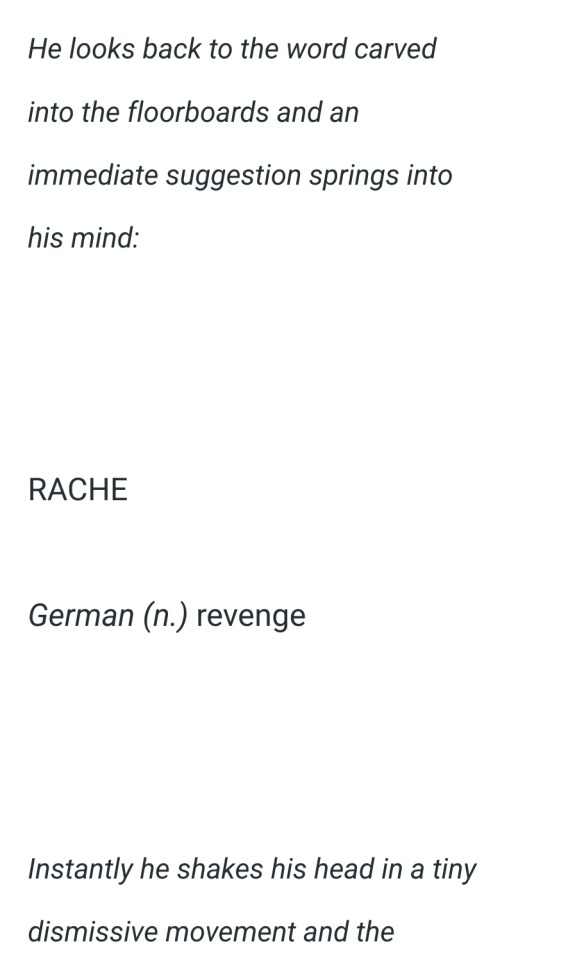
The "obviously" is what Sherlock outwardly portrays to others, specifically Anderson - the scene is of course a nod to the original (while switching it up a bit because that's what adaptations are meant to do) but the scene is also part of a larger plot/episode, and it helps establish the sort of relationship Sherlock and Anderson have. His dismissal of the idea is intentional and who he is dismissing is also intentional for purposes beyond being a nod to the original.
So like, someone might be able to come to the conclusion "bbc sherlock was focused on one upping and not showing love to the original" but not using this scene as an example.
~
If you look at OP's thoughts as a sort of "deduction" about the show/the intents of the writers, we can note a few deduction lessons here:
1. Don't look at something in a vacumn; think about the wider context surrounding something.
Immediate context: Who is Sherlock speaking to? What is going on inside Sherlock's head surrounding his actual dialogue? (since in this show we often have access to that! use everything you have access to with deductions)
How to apply to real life deduction: look at where someone is, who someone is talking to, etc.
You can go further too - the wider context here is this is a TV show: a specific structure that needs to be followed - characters need to be established, conflict needs to happen, etc. (thus it making sense to conclude that Sherlock was written to react that way to Anderson specifically in order to establish that character relationship)
How to apply to real life deduction: the wider context would be like, what country/city is the person in, what is their culture, what is their life like beyond the instance you're observing?
2. Don't jump to conclusions (or jump to throw evidence at a conclusion). Tread carefully!
Sometimes, you might have a potential deduction, based on a few pieces of evidence, but not quite enough information to be sure. So, you look for other evidence (observations, etc.) that could support that deduction.
I don't recommend making that a habit, but if you're doing that, make sure you review the evidence carefully before using it to support your deduction!
Because here, if OP had considered the context of the scene more, OP would have realized that the scene does not support the conclusion.
~
#like there are definitely elements of bbc sherlock that are mainly about one upping the original#but this aint it#tho like#one upping and showing love arent mutually exclusive#and adaptations should be trying to do both#deduction#sherlock holmes#sleuth2k7#deductionist#deduce#learning deduction
16 notes
·
View notes
Text
These are both deductions, but both involve different things, so I wanted to talk about them. We're gonna work backwards to get an idea of how these deductions were made.
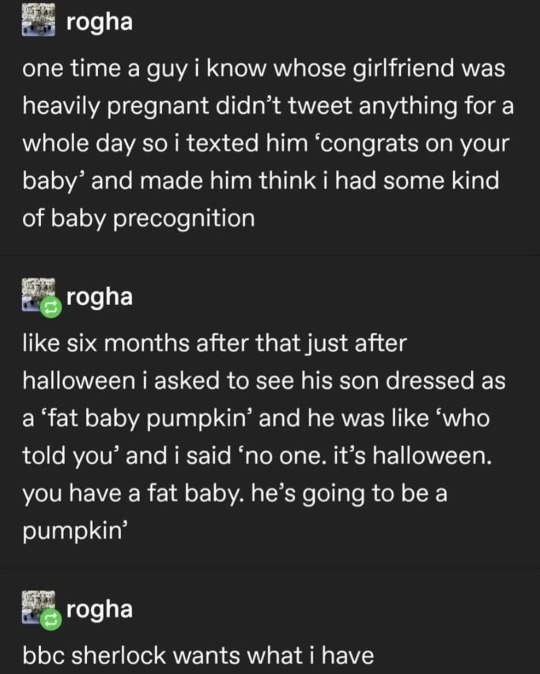
With the first one, rogha had a baseline of his friend and his friend broke the baseline - that is the main way that rogha was able to deduce that his friend's baby had been born.
To make that deduction, the baseline must have been that rogha's friend is an active Twitter user - it is uncommon for him to not be active on Twitter for a day. So, when he was, rogha could have asked: what could cause him to be occupied enough to not be on Twitter? If he is normally active on Twitter daily, then normal, daily activities like work/school/etc. would not be the cause. So *something* not typical happened to rogha's friend that day - something that took up a significant portion (if not all) of the day.
This is where knowledge about his friend helps - his friend has a heavily pregnant wife, who could go into labor at any time, so his wife going into labor is a likely reason for his friend to not be on Twitter.
Of course, a different *something* could have come up, so there was some risk involved in this deduction, but rogha turned out to be right.
With the second one, baselines are not really involved. Instead, rogha is relying on an understanding of the culture & typical behavior of where he and his friend live. In their environment/culture, "pumpkin" is a very popular Halloween costume for infants (and toddlers) - so it is easy and readily available to buy (Note: I know from my experience how popular a costume "pumpkin" is and has been for several decades in the U.S., so for the purposes of this post I'm assuming this is the United States).
Of course, just because the costume is popular does not mean every couple with a baby dresses their baby up as a pumpkin - there are outliers. But is rogha's friend likely to be an outlier? This requires rogha to have knowledge of his friend and what other sorts of costumes are possible. One possible costume route is what I'll call the nerd route - while pumpkin is a popular costume in general, for nerdier people, dressing up as a character from a piece of media for Halloween may be the preferred choice over a more "popular" or "standard" Halloween costume (think pumpkins, cats, witches).
For a young couple and baby, a nerd costume example would be doing Han Solo, Leia, and Baby Yoda. Rogha must know enough about his friend to know that his friend is not a "nerdy Halloween" type of guy (or his wife wouldn't be interested in that at least), so he is more likely to go the standard, popular route - thus, fat baby pumpkin is a likely choice. Again, there's a risk in this deduction, but rogha came to the "most likely" conclusion both times and ended up being spot on.
3 notes
·
View notes
Note
Hi there hello I need to use my evil booping powers, turn on your boops? Pretty please? With not one, but two cherries on top?
I'm gonna be so honest I have no idea what this booping thing is or how to turn it on
1 note
·
View note
Note
Merry Christmas :D
and a happy new year xD
1 note
·
View note
Text
made a fun (well, utterly mundane but shh) deduction today
came home after class and someone had tidied up the inside of the fridge - since it wasn't me, it was either my mom or a specific sister
but! I knew it was my sister right away because right now we have 3 coffee creamers - one of which I've been using in my mom's coffee for the past week, and she's said she likes it and I've told her which I was using, showed the bottle to her etc.
and the creamers had been organized into a line, with the one I'd been using in the very back - unlikely that my mom would do that knowing I've been using it, so my sister mustve done the tidying (and she had!!)
13 notes
·
View notes
Text
#idk who simon is but i love him
@sleuth2k7 david simon, creator and showrunner of the wire and an overall real one!!
Possibly the greatest NPR exchange ever recorded
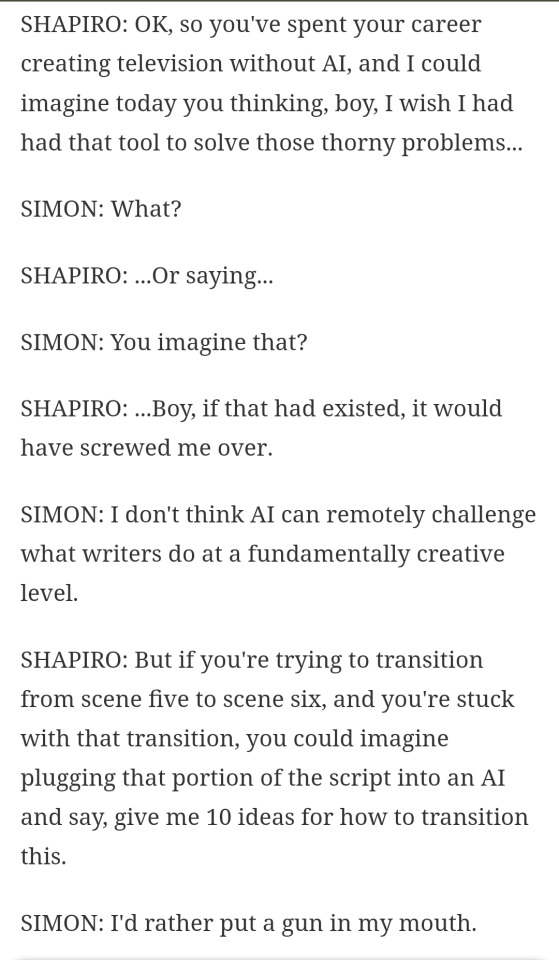
100K notes
·
View notes
Text
Deduction server!
Yo! Are you a deductionist (or an aspiring deductionist) looking for an active community to join?
@froogboi and I have been working on an idea for a deduction discord server and we're looking for people to join!
"What We Know" deduction server description:
Deduction is a broad and complicated subject, this server is a continuous collaboration with everyone who joins to deepen our understanding of the subject. This server is for everyone to share what they know about deduction, no mater how small, so that everyone can benefit. Aims to support academic and social pursuits related to deduction. Come join to share what you know and make some friends!
A few additional details on the server:
- We will be starting with a limited number of people, and then expanding in the future.
- We hope to avoid a "dead" server through optional opportunities to participate in discussions and exercises on a weekly/biweekly basis.
(If you think that you are presently too busy to participate at least a few times a month, then this may not be the server for you at this time, since the server's purpose is to provide a community for people to help them learn deduction.)
- While it's okay if you don't know a lot about deduction or haven't been practicing deduction for very long, we would like the initial group to have some basic knowledge of deduction.
If you're interested, please message me!
About me: I'm CG and I've been deducing on and off since 2015. In learning deduction, I focus on observation, baselines, and using deduction as a communication tool. I also think exploring the wider significance/context of deduction is pretty cool. :)
#deduction#observation#sherlock holmes#deductionist#deductive reasoning#deduce#learning deduction#sherlockholmes#sleuth2k7
14 notes
·
View notes
Text
also! had an interesting language (speech?) observation in my first class today
a student mentioned that another professor (Prof A) (a fairly new one who has taught just 1 class, which I took) had mentioned a theory related to what this professor (Prof B) was talking about
and Prof B looked surprised for a hot second? and then stammered just a tad and said something along the lines of "huh good for her" (not those exact words but that's the vibe I got) and then pivoted with an "anyway" which mmmm was weird
like typically if someone says "huh good for them" in that sort of way, they're indicating dislike but being sort of polite about it right (at least in my experience in the U.S.)
im hesitant to come to that conclusion from 1 mention though, so I'll definitely be paying attention to situations where Prof A is mentioned again (very possible, since several of us are taking a 2nd class with her now)
8 notes
·
View notes
Text
i’ve just started reading jean aitchinson’s seeds of speech and she includes a metaphor that reminded me of deduction, specifically going from observations to deductions:
“‘Science is built up with facts, as a house is with stones. But a collection of facts is no more a science than a heap of stones is a house,’ said the French scientist Jules Poincare. In house building, it’s essential to have an overall plan, and not just heap up stones randomly. Similarly, in research, it’s important to have a theory, a framework into which to place the pieces. If they do not fit, then the old theory has to be abandoned, and a new one proposed. But how can the stones be structured, when it’s unclear what kind of building is under construction?
Sometimes, an intermediate stage is needed, before a full plan is possible. An architect starts by asking basic simple questions, such as: ‘What is the building for?’ An answer such as: ‘To provide shelter from the weather’ leads to other questions, such as ‘What kind of weather, hot or cold?”, “How many people must it shelter?”, and so on.”
two things with this:
1. the theory thing, the framework: you can’t just collect observations and then toss them together however you want, since their meaning isn’t up to your personal creative interpretation - that’s why knowledge bases, logic, etc. are important - you have to not only collect the stones but also have the knowledge of how to put them together, or else you just have a pile of stones
2. the asking questions in my mind is the same as looking at the context - you can observe someone carrying around a heavy coat, but you aren’t going to have any idea what that means unless you ask: (1) what are heavy coats for? and (2) where is this person right now? (context).
#sleuth2k7#whooo metaphors#sherlock holmes#deduction#the building metaphor is not new to deduction#but i liked how this quote put it#especially with the needing to ask questions to figure out the plan for building the house
10 notes
·
View notes
Note
for anyone interested in deducing people's sexualities generally (so straight vs queer rather than specific sexualities), I'd recommend looking into lavender linguistics (aka LGBT linguistics)
disclaimer: i'm referencing English speaking people/places specifically, as most of the resources/research I include focus on English speakers (though other languages/cultures are mentioned)
there's basically two sides to this linguistics niche: slang/language used, and speech patterns/ways of speaking. the former I would not really recommend relying too much on for deduction, since queer slang has integrated itself into popular culture a lot in the last few years so "someone using a lot of queer slang" is not necessarily a great indicator that said person is LGBT (though, that depends on where you are in the world - but I won't get into that in this post). so, let's focus on the latter: speech patterns/ways of speaking.
if you're interested in exploring LGBT linguistics as a knowledge base to help you deduce sexuality, I'd recommend the following for an overview to get you started:
overview of LGBT linguistics
linguistic profiling (with a section on gender/sexuality - this entire page is cool for deduction though)
gay men speech patterns (as mentioned, loads of research on this group in particular)
The Production and Perception of a Lesbian Speech Style (this 2015 research paper super succinctly summarizes several decades worth of research on LGBT linguistics in general which is amazing, and then does their own study on lesbians in particular)
if you're a video/audio person, this guy summarized a research article that basically explored how gay men change their voice in different social situations (he also points out how "what makes someone sound gay" changes from place to place)
final disclaimer, the reason this post is "a few resources to help you learn about LGBT linguistics" and not "how to use linguistics to deduce sexuality," is that this sort of info can be helpful for you to use as a piece of the puzzle of deducing sexuality. not every gay man has the linguistic indicators of the "stereotypical gay man" voice, not every lesbian lowers their voice, etc. - so that is something to keep in mind.
Can you deduce sexuality?
Hello! i think i'm gonna have to make a post about these "can you deduce..." questions cause the answer's technically always the same: yes
By it's very nature, deduction can be applied to anything, this is sort of like asking "can you drive me to [insert location]", the answer's technically always yes, it just depends on if you know the route, if you now the place you're in well enough, if you have a map or gps, if you have a car, if you have gas, etc. But assuming everything's in order and you know what you're doing, yeah you can drive basically anywhere that's not cut off by a whole ocean. In the same way, as long as everything's in order, you have the right skills, and you know what you're doing, yes, you can deduce basically anything
Now, to focus on sexuality specifically, like every other question i've answered (and probably will keep answering) about how to deduce specific stuff, it's just a matter of using what's available to you. Ask yourself, objectively, what would be connected to sexuality, and then look for those things
For example, any sexuality apart from heterosexuality has strong connections to the LGBTQ+ community, and people who have strong connections to that community tend to want to showcase it using pins, or stickers, or pronouns in their bio, or a plethora of other stuff. Now, does this mean that's irrefutable proof that someone's gay for example? no, but it's one clue that gets you closer to that potential conclussion. Now say that this person has a pin of the gay pride flag, well there you go, there's not many other explanations for that, you deduced that they're gay, not a difficult deduction, but a deduction nonetheless.
Assuming the situation is more complex than that, well you'll need to find more evidence, what other things are related to different sexualities? Well, at least when we deal with straight, gay, lesbian, and bi individuals who don't fall into the handful of categories that involve having to know someone or their personality to experience physical attraction, then you're gonna see them show signs of being physically attracted to certain people. Anything from the typical dilation of pupils and elevated heart rate, to just straight up checking people out, and that might just be a dead give away. Basically what i'm trying to get at is: like everything else in deduction, look for adjacent things that point towards what you're trying to find out
8 notes
·
View notes